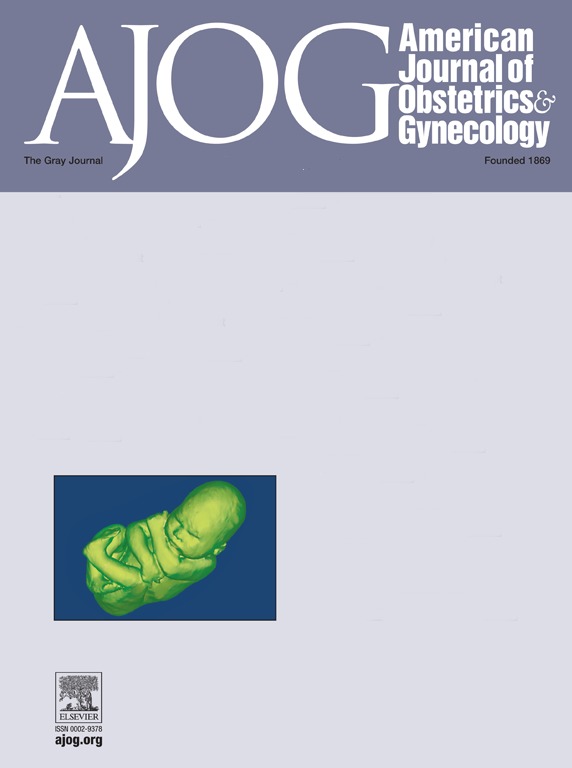Continuous glucose monitoring: criteria for the diagnosis of type 2 diabetes mellitus with clinical obesity after gestational diabetes.
IF 8.4
1区 医学
Q1 OBSTETRICS & GYNECOLOGY
引用次数: 0
Abstract
OBJECTIVE To compare Continuous Glucose Monitoring (CGM) to American Diabetes Association (ADA) criteria, in the postpartum period in women who had developed gestational diabetes (GDM) during their recent pregnancy, for diagnosis of type 2 diabetes (DMT2) complicated by clinical obesity. STUDY DESIGN Between September 2023-April 2025, we conducted a multiproposal cohort study at King's College Hospital, London, UK. We invited consecutive women with and without GDM at 5-months postpartum. GDM patients were also invited for a 1-year follow-up clinic. Blinded CGM (Dexcom G7; Dexcom, San Diego, CA) was performed for 10 days. The primary outcome was T2DM with clinical obesity, defined by first, the ADA criteria (HbA1c ≥6.5%, FPG ≥126 mg/dL, or 2-hour OGTT of ≥200 mg/dL), and second, CGM average glucose ≥131.5 mg/dL, which is the mean + 2SD of our non-GDM group. Clinical obesity was defined by the recently published The Lancet Diabetes and Endocrinology Commission, as excess body fat directly affecting the function of organs and tissues. RESULTS We examined 1,118 women, including 276 (24.7%) non-GDM controls at 5- months postpartum, 539 (48.2%) post-GDM at 5-months postpartum and 303 (27.1%) post-GDM at 1-year postpartum. In the non-GDM group the mean + 2SDs average glucose was ≥131.5 mg/dL. At 5-months postpartum in the GDM group, CGM classified 8.9% (48/539) women as DMT2 with clinical obesity and the respective value by the ADA criteria was 4.3% (23/539). Women diagnosed by CGM but not the ADA criteria (n=35) had a worse cardiometabolic profile than those diagnosed by the ADA criteria alone (n=10). Out of the 35 additional cases, classified only by CGM, 26 attended to the 1-year postnatal clinic and all still had an average glucose ≥131.5 mg/dL measured by CGM and abnormal cardiometabolic profile. CONCLUSIONS Postpartum follow-up in women who had GDM should not only focus on dysglycemia but on their cardiometabolic profile. In this respect, CGM is superior to ADA criteria for diagnosis of DMT2 with clinical obesity.连续血糖监测:妊娠糖尿病后2型糖尿病合并临床肥胖的诊断标准
目的比较近期妊娠期发生妊娠糖尿病(GDM)的妇女产后连续血糖监测(CGM)与美国糖尿病协会(ADA)标准对2型糖尿病(DMT2)合并临床肥胖的诊断价值。研究设计:在2023年9月至2025年4月期间,我们在英国伦敦国王学院医院进行了一项多方案队列研究。我们在产后5个月连续邀请了有和没有GDM的女性。GDM患者也被邀请进行为期1年的随访。盲法CGM (Dexcom G7; Dexcom, San Diego, CA)进行10天。主要结局是T2DM合并临床肥胖,首先,ADA标准(HbA1c≥6.5%,FPG≥126 mg/dL,或2小时OGTT≥200 mg/dL),其次,CGM平均葡萄糖≥131.5 mg/dL,这是非gdm组的平均值+ 2SD。最近出版的《柳叶刀》糖尿病和内分泌学委员会将临床肥胖定义为直接影响器官和组织功能的过量体脂。结果:我们检查了1118名女性,包括276名(24.7%)产后5个月的非gdm对照组,539名(48.2%)产后5个月的gdm患者,303名(27.1%)产后1年的gdm患者。非gdm组平均+ 2SDs平均葡萄糖≥131.5 mg/dL。GDM组产后5个月时,CGM将8.9%(48/539)的女性归类为DMT2伴临床肥胖,ADA标准的相应值为4.3%(23/539)。经CGM诊断但未按ADA标准诊断的女性(n=35)的心脏代谢谱比仅按ADA标准诊断的女性(n=10)更差。在35例仅通过CGM分类的额外病例中,26例参加了产后1年的诊所,所有患者的CGM测量的平均葡萄糖≥131.5 mg/dL和异常的心脏代谢谱。结论GDM妇女的产后随访不仅应关注血糖异常,还应关注其心脏代谢谱。在这方面,CGM在诊断DMT2合并临床肥胖方面优于ADA标准。
本文章由计算机程序翻译,如有差异,请以英文原文为准。
求助全文
约1分钟内获得全文
求助全文
来源期刊
CiteScore
15.90
自引率
7.10%
发文量
2237
审稿时长
47 days
期刊介绍:
The American Journal of Obstetrics and Gynecology, known as "The Gray Journal," covers the entire spectrum of Obstetrics and Gynecology. It aims to publish original research (clinical and translational), reviews, opinions, video clips, podcasts, and interviews that contribute to understanding health and disease and have the potential to impact the practice of women's healthcare.
Focus Areas:
Diagnosis, Treatment, Prediction, and Prevention: The journal focuses on research related to the diagnosis, treatment, prediction, and prevention of obstetrical and gynecological disorders.
Biology of Reproduction: AJOG publishes work on the biology of reproduction, including studies on reproductive physiology and mechanisms of obstetrical and gynecological diseases.
Content Types:
Original Research: Clinical and translational research articles.
Reviews: Comprehensive reviews providing insights into various aspects of obstetrics and gynecology.
Opinions: Perspectives and opinions on important topics in the field.
Multimedia Content: Video clips, podcasts, and interviews.
Peer Review Process:
All submissions undergo a rigorous peer review process to ensure quality and relevance to the field of obstetrics and gynecology.

 求助内容:
求助内容: 应助结果提醒方式:
应助结果提醒方式:


